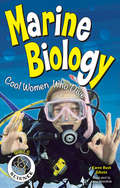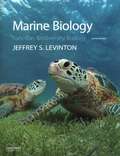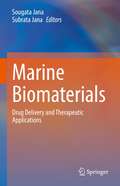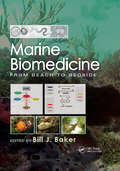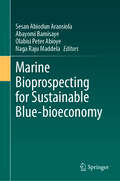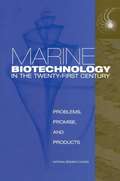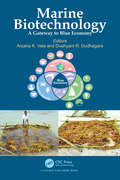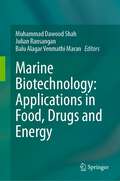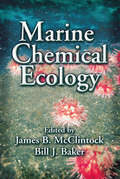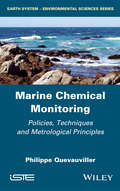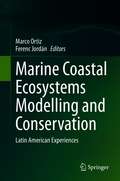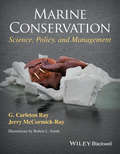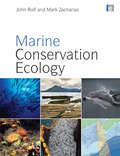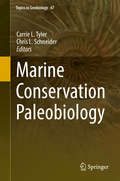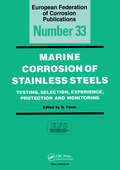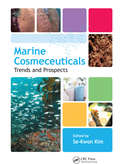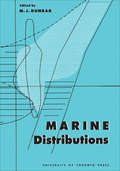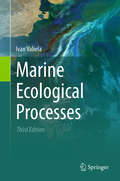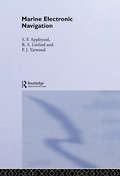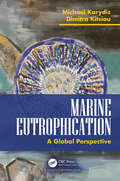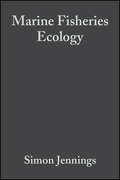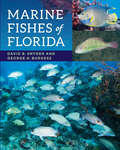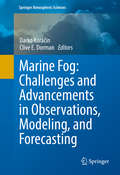- Table View
- List View
Marine Biology: Cool Women Who Dive
by Karen Bush Gibson Lena ChandhokWhy is Earth called the Blue Planet? Because there's so much water on the surface that the planet looks blue from outer space!Marine biology is the study of the plant and animal life in salt water environments, from microscopic plankton to the largest animal on earth, the blue whale. In Marine Biology: Cool Women Who Dive readers ages 9 to 12 explore the careers of three women who work within the science of marine biology-Natalie Arnoldi, Ashanti Johnson, and Lauren Mullineaux.Nomad Press books in the Girls in Science series supply a bridge between girls' interests and their potential futures by investigating science careers and introducing women who have succeeded in science. Compelling stories of real-life scientists provide readers with role models that they can look toward for examples of success.Marine Biology uses engaging content, links to primary sources, and essential questions to whet kids' appetites for further exploration and study. This book explores the history of marine biology, the women who made key discoveries, and the multitude of varied careers in this exciting and important field. Marine Biology encourages both boys and girls to envision what lies beneath the miles of water that make up our planet.
Marine Biology: Function, Biodiversity, Ecology
by Jeffrey LevintonWith its clear and conversational writing style, comprehensive coverage, and sophisticated presentation, Marine Biology: Function, Biodiversity, Ecology, Fifth Edition, is regarded by many as the most authoritative marine biology text. <P><P>Over the course of five editions, Jeffrey Levinton has balanced his organismal and ecological focus by including the latest developments on molecular biology, global climate change, and ocean
Marine Biomaterials: Characterization, Isolation and Applications
by Se-Kwon KimOceans are an abundant source of diverse biomaterials with potential for an array of uses. Marine Biomaterials: Characterization, Isolation and Applications brings together the wide range of research in this important area, including the latest developments and applications, from preliminary research to clinical trials. The book is divided into fou
Marine Biomaterials: Drug Delivery and Therapeutic Applications
by Sougata Jana Subrata JanaThis book is focused on marine based biomedical carriers for delivery of therapeutics. Marine biomaterials and bio-based carriers show wide applications in pharmaceutical as well as biomedical fields for delivery of small and large molecules. Biomaterial-based composites, scaffolds or matrix systems are promising systems for controlled and prolonged release of drug in target site and control the premature release of drugs or bioactive compounds. This book discusses the targeted delivery of drugs and therapeutic applications. It also describes the use of marine biopolymers in cancer therapy. Different chapters describe the tissue engineering techniques to develop these carriers. The marine biomaterial-based systems are widely used for tissue engineering, and biomedical imaging. This book is meant for industry experts, students and researchers in the area of pharmaceutical sciences, biomedical engineering and material science and pharmacology.
Marine Biomedicine: From Beach to Bedside
by Bill J. BakerMarine Biomedicine: From Beach to Bedside assesses current efforts in marine biomedicine and evaluates the implications of recent advances on the future of the field.Richly illustrated in full color to enhance reader comprehension, the book covers four sections. The first one addresses the technology that has recently been brought to bear on the st
Marine Bioprospecting for Sustainable Blue-bioeconomy
by Naga Raju Maddela Sesan Abiodun Aransiola Olabisi Peter Abioye Abayomi BamisayeThis volume comprehensively discusses marine bioprospecting and its applications in the marine bioeconomy, specifically in clean energy generation, and in biomedical, industrial and agricultural sectors. The advent of modern technology, particularly advancements in deep-sea exploration and biotechnology, has enabled scientists to delve deeper into the ocean's depths and discover a treasure trove of unique organisms and compounds. This demonstrates that the rich history of human interactions with the oceans is firmly ingrained in marine bioprospecting. The blue-economy, which is a more accurate name for the systematic search for valuable substances and organisms in the water, has gained popularity in recent years as a possible route for sustainable economic development. One of the key driving factors behind marine bioprospecting is the growing realization that marine organisms possess unique biochemical compounds with the potential to revolutionize various industries. These compounds include novel enzymes, antimicrobial agents, bioactive molecules, and even potential pharmaceuticals. Readers will learn about the applications of these discoveries in bioremediation, wastewater treatment, and biofuel production, as well as the identification of natural substitutes for things that are detrimental to the environment, which include biodegradable plastics derived from marine microorganisms. The primary audience for the book will be governmental and international organizations, professionals, and economists, while the secondary audience will be professors and researchers in the fields of Chemistry, Biotechnology, Environmental Microbiology, and general Ocean Sciences.
Marine Biotechnology In The Twenty-first Century: Problems, Promise, And Products
by Committee on Marine Biotechnology: Biomedical Applications of Marine Natural ProductsDramatic developments in understanding the fundamental underpinnings of life have provided exciting opportunities to make marine bioproducts an important part of the U.S. economy. Several marine based pharmaceuticals are under active commercial development, ecosystem health is high on the public's list of concerns, and aquaculture is providing an ever greater proportion of the seafood on our tables. Nevertheless, marine biotechnology has not yet caught the public's, or investor's, attention. Two workshops, held in October 1999 and November 2001 at the National Academies, were successful in highlighting new developments and opportunities in environmental and biomedical applications of marine biotechnology, and also in identifying factors that are impeding commercial exploitation of these products. This report includes a synthesis of the 2001 sessions addressing drug discovery and development, applications of genomics and proteomics to marine biotechnology, biomaterials and bioengineering, and public policy and essays contributed by the workshop speakers.
Marine Biotechnology: A Gateway to Blue Economy
by Anjana K. Vala Dushyant R. DudhagaraThe marine environment has always been beneficial to mankind in one way or another. With advancements in scientific knowledge and technological development, novel aspects of marine resources have been and are being revealed that can be harnessed for sustainable development of blue economy. The book Marine Biotechnology: A Gateway to Blue Economy is an attempt to present before the scientific community, a compilation of recent developments in the field of marine biotechnology contributed by leading scientists of international repute. The book covers diverse roles of marine biotechnology, including in agriculture, probiotics, health sector, novel biomolecules, biochemicals, biomedicine, and pharmaceuticals.
Marine Biotechnology: Applications in Food, Drugs and Energy
by Muhammad Dawood Shah Julian Ransangan Balu Alagar Venmathi MaranThis contributed volume covers the applications of marine biotechnology for food, drugs and energy production using marine resources. It introduces many aspects of marine biotechnology, including bioenergy, pharmaceutical development, food security from mariculture, pollution handling, legal issues and conflicts. Information in the book is accompanied by clear images, flow charts, quantitative and qualitative data. Marine biotechnology is essential for realizing the previously untapped potential of marine bio-resources. These resources are used to develop innovative goods and procedures that aid in the global management of food, energy, and disease management. The development of innovative tools and solutions for more sustainable marine environmental management is another important section of this title. This reference book is of interest to teachers, researchers, and climate change scientists. It serves as an additional reading material for college, undergraduate, and graduate students of marine science and aquaculture. This is also a good research guide for food and fishing industry scientists.
Marine Chemical Ecology (CRC Marine Science)
by Bill J. Baker James B. McClintockThe interdisciplinary field of marine chemical ecology is an expanding and dynamic science. It is no surprise that the breadth of marine organisms studied expanded in concert with developments in underwater technology. With its up-to-date subject reviews by experts, Marine Chemical Ecology is the most current, comprehensive book on the subject. The
Marine Chemical Monitoring: Policies, Techniques and Metrological Principles (Water Quality Measurements Ser. #29)
by Philippe QuevauvillerCombining laboratory experience with research and policy developments, this book provides an insight into the historical background of marine monitoring, its regulatory frameworks and science–policy interactions. With experience in the European Commission, the author draws from practical experience in research and policy implementation to present a concise review of marine monitoring on an international level. The author deals with monitoring and related QA/QC principles, focusing on monitoring types, while describing general features of analytical methods used in marine monitoring. The book concludes with a discussion about how to achieve metrology principles (measurement traceability) in marine monitoring.
Marine Coastal Ecosystems Modelling and Conservation: Latin American Experiences
by Marco Ortiz Ferenc JordánThe book presents a collection of large-scale network-modeling studies on coastal systems in Latin America. It includes a novel description of the functioning of coastal complex ecosystems and also predicts how natural and human-made disturbances percolate through the networks. Coastal areas belong to the most populated ecosystems around the globe, and are massively influenced by human impacts such as shipping, mining, fisheries, tourism, pollution and human settlements. Even though many of these activities have facilitated socio-economic development, they have also caused a significant deterioration in natural populations, communities and ecosystems worldwide. Covering coastal marine ecosystems of Latin America such as the NE and SE Pacific, NW Atlantic and Caribbean areas, it discusses the construction of quantitative (Ecopath-Ecosim-Ecospace and Centrality of Node Sets) and semi-quantitative (Loop Analysis) multispecies trophic-network models to describe and assess the impacts of natural and human interventions like pelagic and benthic fishing as well as natural events such as El Niño, and La Niña. The book also features steady state (and/or near moving equilibrium) and dynamical models to support the management of exploited organisms, and applies and quantifies macroscopic indices, based on Ascendency (Ulanowicz) and Local Stability (Levins´ Loop Analysis). Further, it discusses the determination of the Keystone Species Complex Index, which is a holistic extension of the classical concept of Keystone Species (Paine), offering novel strategies for conservation monitoring and management.
Marine Conservation
by G. Carleton Ray Jerry Mccormick-Ray Robert L. Smith Jr.Providing a guide for marine conservation practice, Marine Conservation takes a whole-systems approach, covering major advances in marine ecosystem understanding. Its premise is that conservation must be informed by the natural histories of organisms together with the hierarchy of scale-related linkages and ecosystem processes. The authors introduce a broad range of overlapping issues and the conservation mechanisms that have been devised to achieve marine conservation goals. The book provides students and conservation practitioners with a framework for thoughtful, critical thinking in order to incite innovation in the 21st century."Marine Conservation presents a scholarly but eminently readable case for the necessity of a systems approach to conserving the oceans, combining superb introductions to the science, law and policy frameworks with carefully chosen case studies. This superb volume is a must for anyone interested in marine conservation, from students and practitioners to lay readers and policy-makers."--Simon Levin, George M. Moffett Professor of Biology, Department of Ecology & Evolutionary Biology, Princeton University
Marine Conservation Ecology
by John RoffThis major textbook provides a broad coverage of the ecological foundations of marine conservation, including the rationale, importance and practicalities of various approaches to marine conservation and management. The scope of the book encompasses an understanding of the elements of marine biodiversity - from global to local levels - threats to marine biodiversity, and the structure and function of marine environments as related to conservation issues. The authors describe the potential approaches, initiatives and various options for conservation, from the genetic to the species, community and ecosystem levels in marine environments. They explore methods for identifying the units of conservation, and the development of defensible frameworks for marine conservation. They describe planning of ecologically integrated conservation strategies, including decision-making on size, boundaries, numbers and connectivity of protected area networks. The book also addresses relationships between fisheries and biodiversity, novel methods for conservation planning in the coastal zone and the evaluation of conservation initiatives.
Marine Conservation Paleobiology (Topics in Geobiology #47)
by Carrie L. Tyler Chris L. SchneiderThis volume describes and explores the emerging discipline of conservation paleobiology, and addresses challenges faced by established and young Conservation Paleobiologist's alike. In addition, this volume includes applied research highlighting how conservation paleobiology can be used to understand ecosystem response to perturbation in near and deep time. Across 10 chapters, the book aims to (1) explore the goals of conservation paleoecology as a science, (2) highlight how conservation paleoecology can be used to understand ecosystems’ responses to crises, (3) provide case studies of applications to modern ecosystems, (4) develop novel applications of paleontological approaches to neontological data, and (5) present a range of ecosystem response and recovery through environmental crises, from high-resolution impacts on organism interactions to the broadest scale of responses of the entire marine biosphere to global change. The volume will be of interest to paleoecologists, paleobiologists, and conservation biologists.
Marine Corrosion of Stainless Steels: Testing, Selection, Experience, Protection and Monitoring (European Federation of Corrosion Publications)
by D. FéronThis is Number 33 of the Marine Corrosion of Stainless Steels, a publication of the European Federation of Corrosion (EFC). Part I of this volume on the "Marine Corrosion of Stainless Steels" consists of five chapters and is concerned with tests that were conducted in the 1990s on the corrosivity of European sea waters (Atlantic, Baltic, English Channel, Mediterranean, and North Sea) towards three types of stainless steels. Results from these two test programmes were presented at a European Workshop on Sea Water Corrosion of Stainless Steels in Trondheim in 1996 and at various corrosion conferences, mostly in Europe. The other four chapters in Part I describe experimental procedures, critical pitting temperature data, crevice corrosion results and results from the MAST biofilm studies. The remaining 23 chapters of the book are concerned with reviews and reports that develop the above topics.
Marine Cosmeceuticals: Trends and Prospects
by Se-Kwon KimMarine Cosmeceuticals: Trends and Prospects is a consolidated overview of the marine environment as a productive source of novel cosmeceuticals. It accumulates the latest research in this field from around the globe, highlighting the potential of marine micro and macro flora and fauna as effective agents for the development of novel cosmeceuticals.
Marine Distributions (The Royal Society of Canada Special Publications #5)
by Maxwell DunbarA symposium of the Royal Society of Canada was held in June 1962 to outline what is being done in Canadian oceanography to map salinity, temperature, and plankton in the waters around Canada and in the North Atlantic across to Europe. This volume, based on the symposium, emphasizes the interdisciplinary nature of research in marine biogeography and in the distribution of environmental factors in the sea. The book is intended to show the breadth of biogeographic work in the sea, and the relation between biogeography and the physics and chemistry of the marine environment. It serves also to introduce to the scientific public the new Serial Atlas of the Marine Environment, a scientific journal of a new kind of sponsored jointly by the Royal Society of Canada and the U.S. National Academy of Sciences.
Marine Ecological Processes
by Ivan ValielaThe oceans represent a vast, complex and poorly understood ecosystem. Marine Ecological Processes is a modern review and synthesis of marine ecology that provides the reader with a lucid introduction to the intellectual concepts, approaches, and methods of this evolving discipline. Comprehensive in its coverage, this book focuses on the processes controlling marine ecosystems, communities, and populations and demonstrates how general ecological principles--derived from terrestrial and freshwater systems as well--apply to marine ecosystems. Global warming and increased eutrophication and wetland destruction in recent years has made the study of ecological processes even more important for the preservation of marine environments. This thoroughly updated and expanded edition will provide students of marine ecology, marine biology, and oceanography with numerous illustrations, examples, and references which clearly impart to the reader the current state of research in this field: its achievements as well as unresolved controversies.
Marine Electronic Navigation
by Stephen F. Appleyard"This 600 page textbook must be a good candidate for being the authoritative reference on its subject....This book reveals all through a good, clear text amply illustrated... The authors and publisher are to be congratulated on an excellent production."--The Naval Review Well organized, clear and easy to read. The second edition has been enlarged with various items devoted to new electronic equipment now encountered by mariners, especially those concerned with navigational and radiocommunication equipment."--International Hydrographic Bulletin "A major and standard text, now much enlarged and revised with sections on radar, communications, the gyro compass and all navigation systems encountered in merchant ships. Full and expert treatment of all aspects of electronic navigation and communication systems making it one of the leading references on its subjects."--Lloyds List
Marine Eutrophication: A Global Perspective
by Michael Karydis Dimitra KitsiouMarine eutrophication has been recognized as a global problem with adverse effects on ecosystem’s health and the economies of coastal states. Most conventions regarding marine environmental protection of Regional Seas have given priority to eutrophication and relevant management practices. This book presents a global perspective of eutrophication in most of the Regional Seas, including the legal framework, assessment and management practices. Information on ecosystem’s impact as well as an outline of the methods used for assessing eutrophication is also provided. This volume will be useful to research students, marine scientists and policy makers working in marine environmental management. Key Features: Contributes to the understanding of the eutrophication processes and problems Presents an extensive account of the data analysis methods used for the quantitative assessment of eutrophication Looks the eutrophication status of the main regional seas Provides information on eutrophication politics and measures to mitigate eutrophication
Marine Fisheries Ecology
by Simon Jennings Michel Kaiser John D. ReynoldsThis topical and exciting textbook describes fisheries exploitation, biology, conservation and management, and reflects many recent and important changes in fisheries science. These include growing concerns about the environmental impacts of fisheries, the role of ecological interactions in determining population dynamics, and the incorporation of uncertainty and precautionary principles into management advice. The book draws upon examples from tropical, temperate and polar environments, and provides readers with a broad understanding of the biological, economic and social aspects of fisheries ecology and the interplay between them. As well as covering 'classical' fisheries science, the book focuses on contemporary issues such as industrial fishing, poverty and conflict in fishing communities, marine reserves, the effects of fishing on coral reefs and by-catches of mammals, seabirds and reptiles. The book is primarily written for students of fisheries science and marine ecology, but should also appeal to practicing fisheries scientists and those interested in conservation and the impacts of humans on the marine environment. particularly useful are the modelling chapters which explain the difficult maths involved in a user-friendly manner describes fisheries exploitation, conservation and management in tropical, temperate and polar environments broad coverage of 'clasical' fisheries science emphasis on new approaches to fisheries science and the ecosystem effects of fishing examples based on the latest research and drawn from authors' international experience comprehensively referenced throughout extensively illustrated with photographs and line drawings
Marine Fishes of Florida
by George H. Burgess David B. SnyderThe essential illustrated guide to Florida’s marine fishes.The most comprehensive book about Florida's marine fishes ever produced, Marine Fishes of Florida includes hundreds of photographs and descriptions of species you'll encounter—plus many that are rare—when diving, snorkeling, kayaking, or fishing. Coverage includes both the Atlantic and Gulf coastline, from habitats near the shore to deeper waters. Fishes found in coastal rivers and other brackish waters are fully represented, as are offshore species that venture into Florida's waters often enough to be called "occasional visitors." David B. Snyder and George H. Burgess intertwine personal observations with results from research studies to provide accurate—often surprising—details. The result is a set of beautifully succinct identification descriptions coupled with information about each species' natural history. From the largest sharks to the smallest cryptic gobies, from homely toadfishes to the spectacularly colored reef fishes, this book is certain to help you better understand the fish you've seen or hooked.Features of Marine Fishes of Florida include Color photographs by leading marine photographers Differentiation of adult and juvenile forms Coverage of 133 fish families and hundreds of species Size and geographical range data Natural history and conservation notes Explanations of geologic history and current habitats
Marine Fishes of Florida
by George H. Burgess David B. Snyder&“A highly useful and interesting reference for ichthyologists, recreational fish enthusiasts and those working in Florida waters . . . a worthy addition.&” —Marine Biology Research The most comprehensive book about Florida&’s marine fishes ever produced, Marine Fishes of Florida includes hundreds of photographs and descriptions of species you&’ll encounter—plus many that are rare—when diving, snorkeling, kayaking, or fishing. Coverage includes both the Atlantic and Gulf coastline, from habitats near the shore to deeper waters. Fishes found in coastal rivers and other brackish waters are fully represented, as are offshore species that venture into Florida&’s waters often enough to be called &“occasional visitors.&” David B. Snyder and George H. Burgess intertwine personal observations with results from research studies to provide accurate—often surprising—details. The result is a set of beautifully succinct identification descriptions coupled with information about each species&’ natural history. From the largest sharks to the smallest cryptic gobies, from homely toadfishes to the spectacularly colored reef fishes, this book is certain to help you better understand the fish you&’ve seen or hooked. Features of Marine Fishes of Florida include: Color photographs by leading marine photographersDifferentiation of adult and juvenile formsCoverage of 133 fish families and hundreds of speciesSize and geographical range dataNatural history and conservation notesExplanations of geologic history and current habitats&“Entertaining and informative . . . I think this book will be a great addition to the library of any biologist, fisher, diver or student, and I strongly recommend this book to anyone wishing to expand their knowledge of Florida fishes.&” —Environmental Biology of Fishes
Marine Fog: Challenges and Advancements in Observations, Modeling, and Forecasting (Springer Atmospheric Sciences)
by Darko Koračin Clive E. DormanThis volume presents the history of marine fog research and applications, and discusses the physical processes leading to fog's formation, evolution, and dissipation. A special emphasis is on the challenges and advancements of fog observation and modeling as well as on efforts toward operational fog forecasting and linkages and feedbacks between marine fog and the environment.
